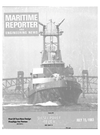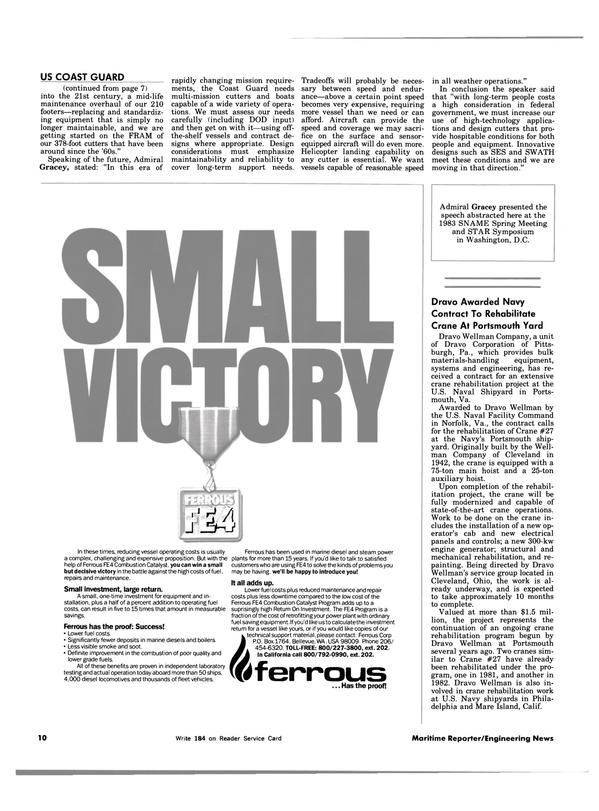
Future Requirements Of Coast Guard Vessels
"The problem is change and how to cope with it. I have learned that 90 percent of problem solving is realizing that you have a problem," stated Adm. James S. Gracey, Commandant, U.S. Coast Guard, at the 1983 Society of Naval Architects and Marine Engineers' Spring Meeting/STAR Symposium in Washington, D.C.
The Steering Committee for the Spring Meeting had asked Admiral Gracey to speak on: (1) what are the major changes affecting the Coast Guard, (2) what will be the impact of these changes on marine engineering, and (3) what are the likely Coast Guard requirements for the U.S. marine industries over the next 10 years.
The speaker found these questions to be most apropos for the Coast Guard, stating: "With the Coast Guard, you have certainly come to the right organization to talk about 'change' . . . if there is any institution that understands the meaning of the word, it is the Coast Guard. Over the years, we have grown from a single-mission service, the revenue cutter service created back in 1790 to enforce the revenue against smugglers bent on avoiding taxes, into a multimission armed force of the United States with tasks ranging from search and rescue to military readiness to environmental protection.
We have expanded and contracted, fought in every armed conflict of this nation, changed departments and coped with a number of considerably different political philosophies along the way." Referring to the economy and the federal budget, Admiral Gracey spoke of the effect of inflation, the cost of people (wages) and the procurement of equipment. While cutting personnel expenditures is a major problem, according to the Admiral, he feels that the Coast Guard is being funded reasonably well to procure equipment.
His solution to these problems is: "One way we can compensate for that lack of people is to take full advantage of state-of-the-art technology—computers, electronics and sensors—the whole range of ways to work smarter, not harder. Fortunately, the high technological industries are rapidly increasing in both availability and capability, while at the same time costs are going down. We have to implant that technological innovation in our ship design and operation. The COMDAC equipment on our 270-foot Bear Class cutters is a good example. We have probably reduced the crew of these ships by one-third through computerizing navigation, communications, engineering and weapons control capability." Admiral Gracey pointed out that increasing the use of technology does not necessarily increase capability but it does increase efficiency.
When you reduce crew size, he advised, every component on the ship can be reduced—evaporators, galley, berthing, heating—resulting in savings in raw materials for initial construction and energy savings during operation.
These savings can compensate for being "people-poor" in the future.
The Coast Guard's aim, according to Admiral Gracey, is to assure its officers and enlisted men that they "will be operating the best equipment—the best boats and best cutters available. That means quality construction; it means people-oriented vessels that are safe and comfortable. And that is why we are looking at innovative hull designs such as SWATH and SES—ships that will operate at good speed, comfortably, in all kinds of weather. Not only must our ships have the legs to go the distance but our people must be able to man them at peak efficiency when the going gets rough.
We already have two Bell-Halter SES's operating in the Caribbean and a third will be delivered later this year. Also, we are designing a mid-size cutter, somewhere between our 210-foot cutters and the 82/95-foot patrol boats that will be a SWATH vessel." The speaker pointed out that the government expects the Coast Guard to keep its ships operating forever and this requires reliability and maintainability. To meet this expectation, the Admiral said: "It has to be built-in at the design stage and requires quality construction.
We generally build for a ship life of 30 years. But experience shows our cutters have to last much longer. We are currently doing a ship-life extension program on our 180-foot buoy tenders (built in the '40s) to carry them on into the 21st century, a mid-life maintenance overhaul of our 210 footers—replacing and standardizing equipment that is simply no longer maintainable, and we are getting started on the FRAM of our 378-foot cutters that have been around since the '60s." Speaking of the future, Admiral Gracey, stated: "In this era of rapidly changing mission requirements, the Coast Guard needs multi-mission cutters and boats capable of a wide variety of operations.
We must assess our needs carefully (including DOD input) and then get on with it—using offthe- shelf vessels and contract designs where appropriate. Design considerations must emphasize maintainability and reliability to cover long-term support needs.
Tradeoffs will probably be necessary between speed and endurance— above a certain point speed becomes very expensive, requiring more vessel than we need or can afford. Aircraft can provide the speed and coverage we may sacrifice on the surface and sensorequipped aircraft will do even more.
Helicopter landing capability on any cutter is essential. We want vessels capable of reasonable speed in all weather operations." In conclusion the speaker said that "with long-term people costs a high consideration in federal government, we must increase our use of high-technology applications and design cutters that provide hospitable conditions for both people and equipment. Innovative designs such as SES and SWATH meet these conditions and we are moving in that direction."
Read Future Requirements Of Coast Guard Vessels in Pdf, Flash or Html5 edition of July 15, 1983 Maritime Reporter
Other stories from July 15, 1983 issue
Content
- Future Requirements Of Coast Guard Vessels page: 6
- Dravo Awarded Navy Contract To Rehabilitate Crane At Portsmouth Yard page: 10
- DIESEL POWER REVIEW page: 12
- Dubai Dry Dock Begins Operations page: 40
- Pan-American Naval Engineers To Hold 1983 Meeting In Washington page: 40
- Beier Offers Free Brochure On Nav/Com Equipment Certified Compass Repairs page: 41
- New Engine Program For Sterndrive Packages Detailed In Free Literature page: 42
- Gulf Fleet Marine Offers 20-Page Color Brochure Describing Vessels, Service page: 42
- New Design For Firefighting—Pemex 652 page: 43
- Service Machine Group Develops Plans for a Diving Support Vessel page: 43
- Construction Underway On ACL's Five 36,000-Dwt "Leader Ships" page: 46
- Tracor Marine Announces Two Executive Appointments page: 46
- Marco To Build 75-Foot Tug For Hawaiian Island Service page: 48
- Alaska Ferry Maintenance Yard Under Construction In Ketchikan page: 58


